Introduction
- Brain stimulation is a method of interrupting the brain function by introducing electric current.
- Scientists use brain stimulation to understand brain functions, neurological, and psychological conditions.
- It is also important in treating some medical conditions , such as chronic pain, hard-to-treat anorexics, major depression, and tourette syndrome.
- There are new discoveries in brain stimulations (Hallam, 2013).
Brain stimulation therapies involve activating or touching the brain directly with electricity, magnets, or implants to treat depression and other disorders.
Brain stimulation originated from psychiatric care procedures of the 1950s and 1960s.
Treatment of tourette syndrome remains an experimental procedure.
Deep brain stimulation may also help in hard-to-treat anorexics (Hallam, 2013, p. 1).
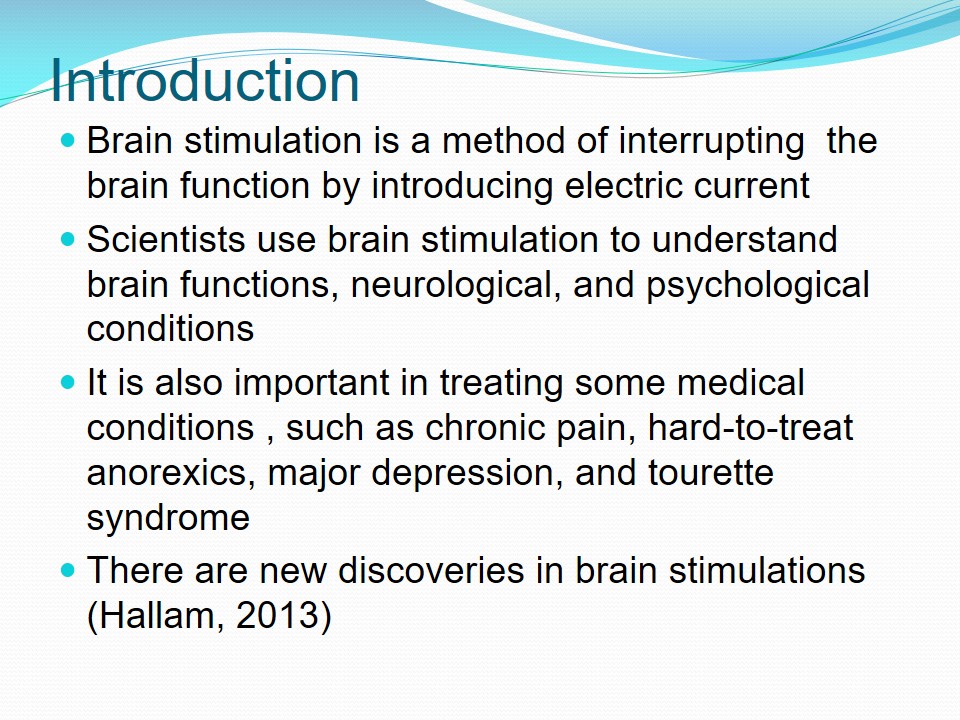
Human Psychology and Brain Stimulation
Dewey (2007) noted that some reactions to brain stimulation are:
- Emotions.
- Forced thoughts.
- Odours and tastes.
- Spatial illusions.
- Visual constructions.
- Auditory illusions.
- Music.
- Movement.
- Vocalization (Dewey, 2007, p. 1).
The above are some of the responses to brain stimulation that Penfield documented.
The brain is a part of the mind (Dewey, 2007, p. 1). Therefore, electrical stimulation can trigger such varieties of responses when exposed to the cortex.
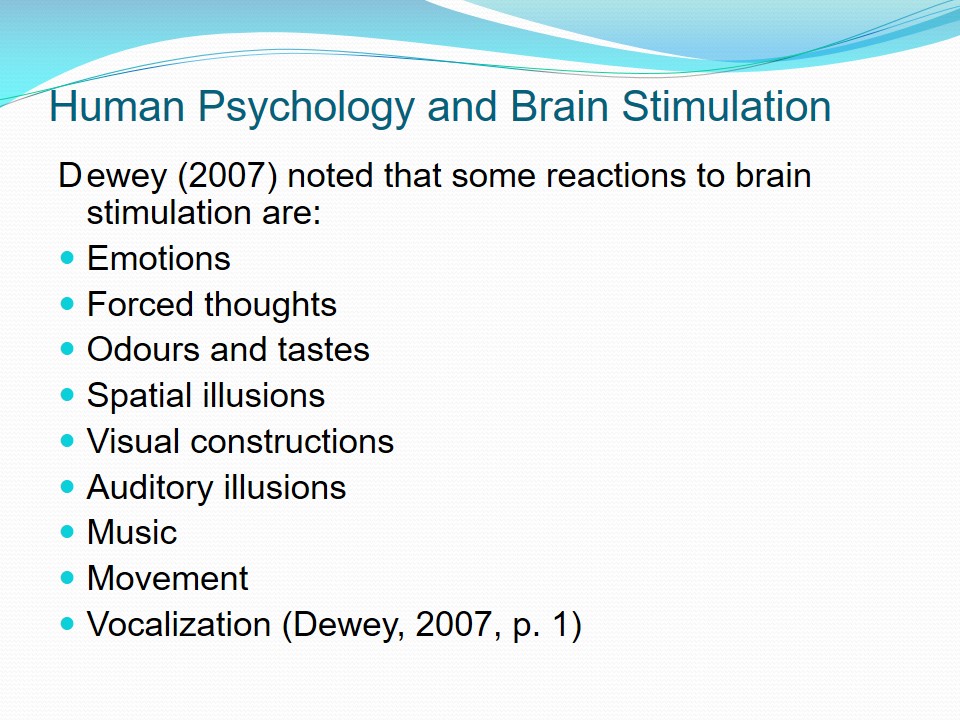
Therapies of Brain Stimulation
There are a number of brain stimulation therapies with various procedures (National Institute of Mental Health, 2009, p. 1). These are:
- Electroconvulsive therapy.
- Vagus nerve stimulation.
- Repetitive transcranial magnetic stimulation.
- Magnetic seizure therapy.
- Deep brain stimulation.
Brain stimulation therapies entails the use of “electricity, magnets, or implants to treat depression and other disorders” (National Institute of Mental Health, 2009, p. 1).
Electroconvulsive therapy is the most common and widely researched.
The new experimental methods include vagus nerve stimulation, repetitive transcranial magnetic stimulation, magnetic seizure therapy, and deep brain stimulation.
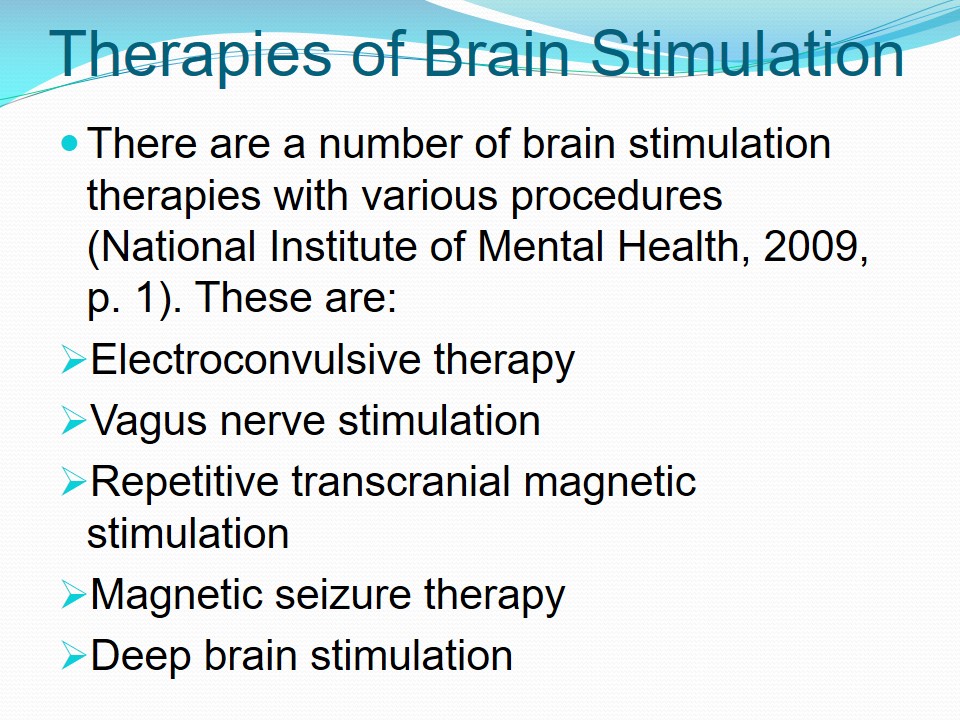
Deep Brain Stimulation (DBS)
- DBS involves “implanting electrodes in the brain with the aim of delivering electric current to given areas” (National Institute of Mental Health, 2009, p. 1).
- The aim is to interrupt electrical signals in order to address conditions like tremors.
- Deep brain stimulation does not cause permanent changes.
- The surgeon gather feedback when the patient is awake.
- DBS relies on brain surgery and procedure is reversible.
- The underlying principles of deep brain stimulations remain vague.
Researchers use techniques with “low-levels of invasion like transcranial magnetic stimulation in order to generate small electrical currents” (National Institute of Mental Health, 2009, p. 1).
DBS has risks like any other surgery of the brain.
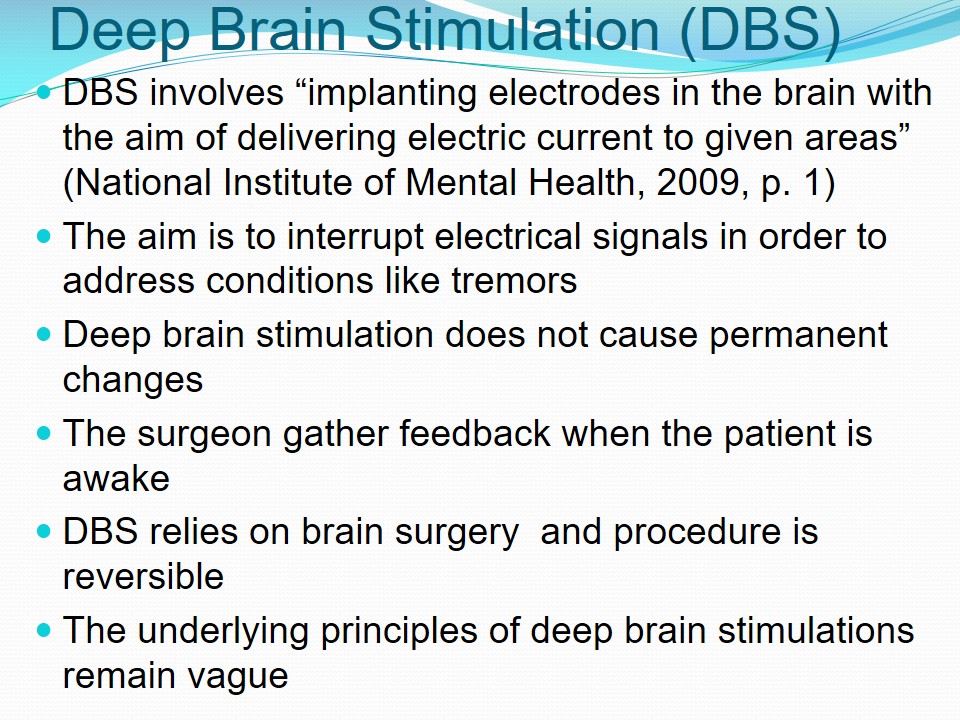
Deep brain stimulation & Repetitive transcranial magnetic stimulation
Deep brain stimulation (DBS): this therapy was the first approach for treatment for Parkinson’s disease in order to reduce “tremor, stiffness, walking problems and uncontrollable movements” (National Institute of Mental Health, 2009, p. 1).
Repetitive transcranial magnetic stimulation (rTMS): this method relies on a magnet rather than an electrical current to activate the brain. rTMS has been under study as a potential way of treating “depression, psychosis and other disorders since late 1990s” (National Institute of Mental Health, 2009, p. 1).
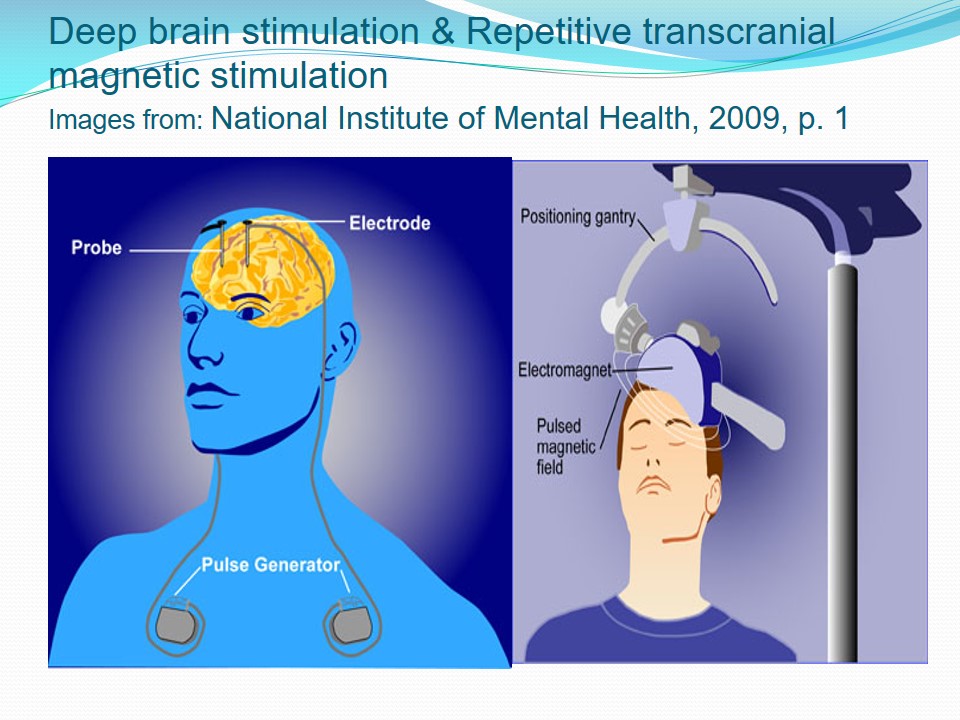
Application
- Mental disorder.
- Parkinson’s disease.
- Chronic pain.
- Major depression.
- Tourette syndrome.
- Obsessive-compulsive disorder.
It has three components. These are:
- Implanted pulse generator (IPG).
- Lead.
- Extension.
Implanted pulse generator (IPG): is a battery-powered neurostimulator enclosed in a titanium that transmits electrical pulses to the brain to interrupt neural processes at the target site.
Lead: this consists of a coiled wire protected in polyurethane that has four platinum iridium electrodes. It is placed in one of three areas of the brain.
Extension : this connects the lead and the IPG.
The application of brain stimulation techniques differ. Several researchers have embarked on further studies in order to find safe and other ways of treating brain condition by using brain stimulation techniques (National Institute of Mental Health, 2009, p. 1).
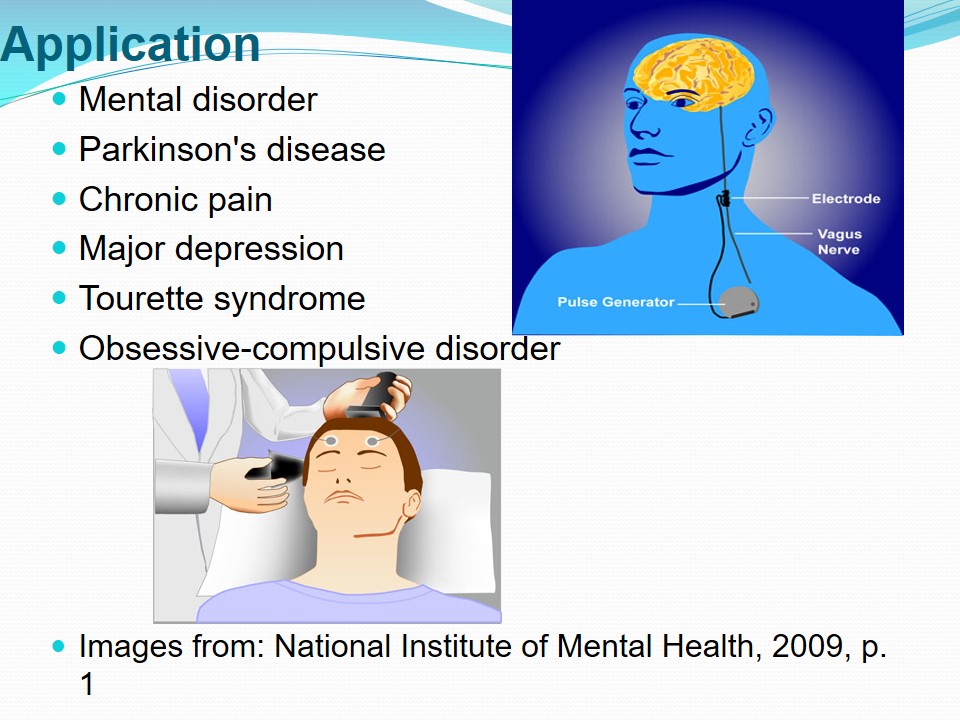
Availability
- Some basic forms of brain stimulations have been in use since 1980s.
- These procedures are under constant review and improvements.
- Brain stimulation remains experimental in some countries and only available to people willing to participate in experiments and clinical trials.
- Others areas have skilled neurosurgeons to perform the surgery.
- Not all insurance companies cover these treatments.
Some new methods of brain stimulations are still under study. The FDA had approved DBS for treatment of Parkinson’s disease.
Meanwhile, the FDA has not particularly approved DBS of the thalamus to treat multiple sclerosis. It is important to understand how DBS works before seeking medical surgery. In some cases, the insurance company may consider such interventions as experimental and avoid providing cover to the patient.
The experimental nature of many brain stimulation therapies limit their availability.
Repetitive transcranial magnetic stimulation (rTMS): this therapy has been available after approval from FDA in 2008. It helps in treatment of “depression for patients who have not responded to at least one antidepressant medication” (National Institute of Mental Health, 2009, p. 1).
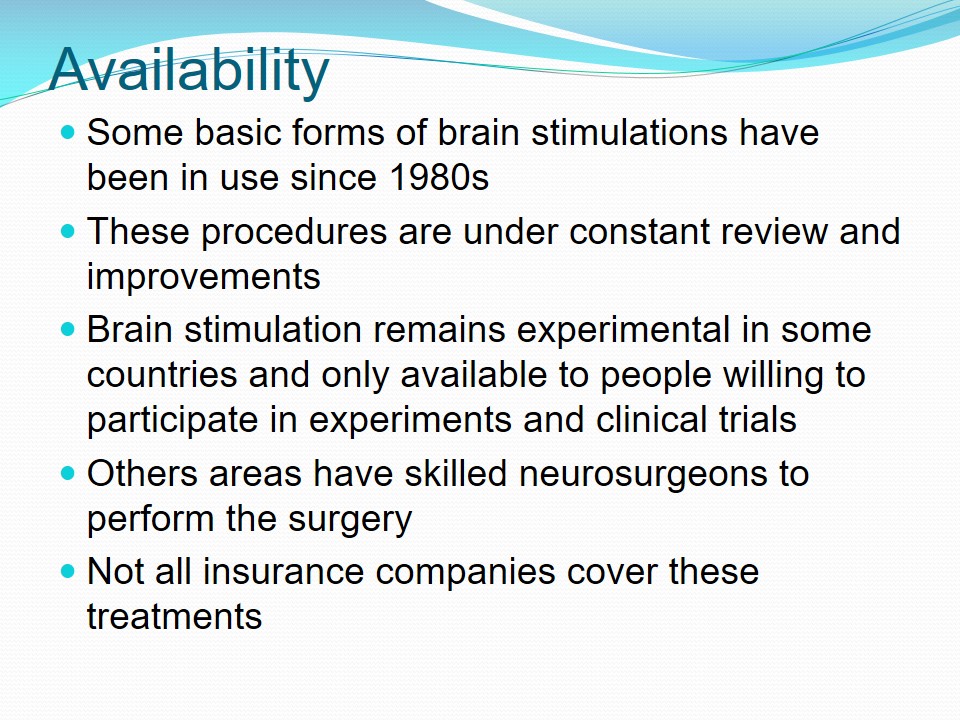
Summary and On-going studies
Based on psychobiological research, brain stimulation has provide treatment for certain mental conditions like depression, psychosis, Parkinson’s disease, mood, especially depressive symptoms, bipolar disorder or schizophrenia.
Brain stimulation research has brought new scientific studies to manage hard-to-treat mental disorders.
This is an area of high interests among researchers with several tests on-going in specific areas.
Some treatment techniques are new and their effectiveness or safety are still under investigation.
Side effects may vary depending on the type of therapy used:
- Bleeding in the brain or stroke.
- Infection.
- Disorientation or confusion.
- Unwanted mood changes.
- Movement disorders.
- Trouble sleeping.
These therapies are under experiments. Therefore, other side effects may be possible.
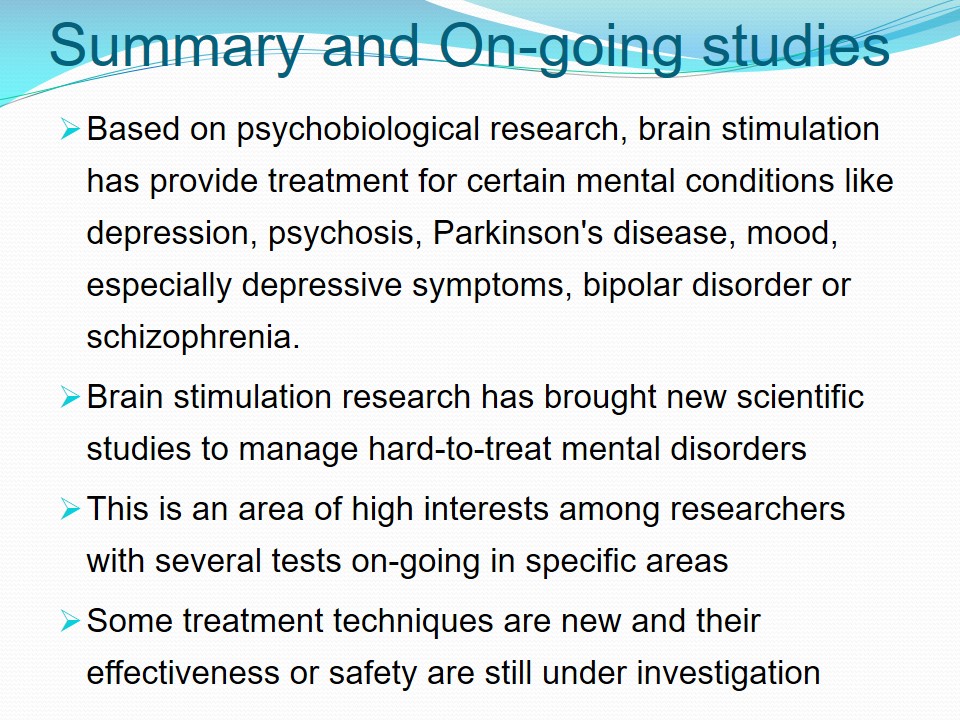
Reference List
Dewey, R 2007, Other Psychological Responses to Brain Stimulation. Web.
Hallam, K 2013, Deep-Brain Stimulation May Help Hard-to-Treat Anorexics. Web.
National Institute of Mental Health, 2009, Brain Stimulation Therapies. Web.